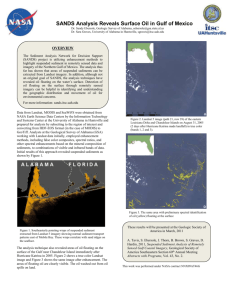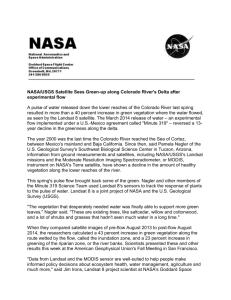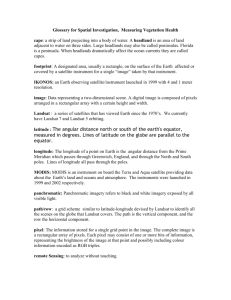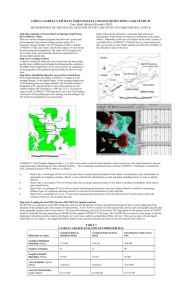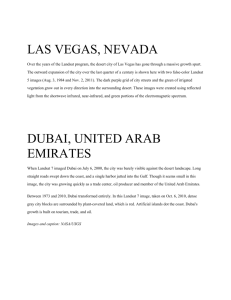Landstat Data available on the Internet Jenny Houge, Robert Bates
advertisement
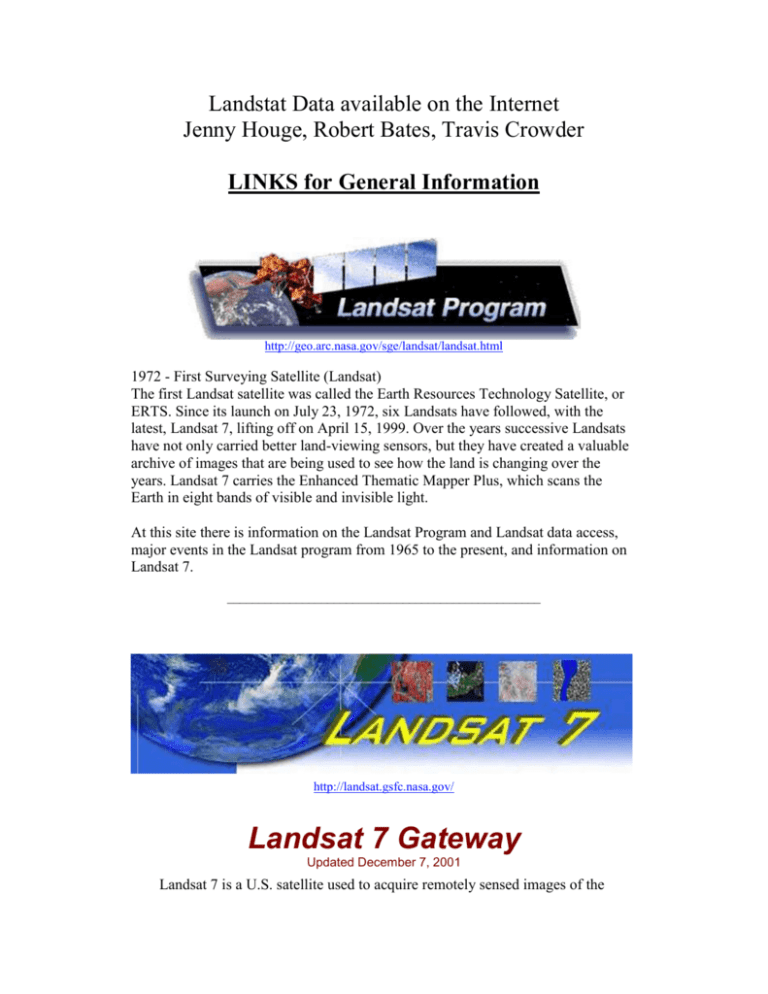
Landstat Data available on the Internet Jenny Houge, Robert Bates, Travis Crowder LINKS for General Information http://geo.arc.nasa.gov/sge/landsat/landsat.html 1972 - First Surveying Satellite (Landsat) The first Landsat satellite was called the Earth Resources Technology Satellite, or ERTS. Since its launch on July 23, 1972, six Landsats have followed, with the latest, Landsat 7, lifting off on April 15, 1999. Over the years successive Landsats have not only carried better land-viewing sensors, but they have created a valuable archive of images that are being used to see how the land is changing over the years. Landsat 7 carries the Enhanced Thematic Mapper Plus, which scans the Earth in eight bands of visible and invisible light. At this site there is information on the Landsat Program and Landsat data access, major events in the Landsat program from 1965 to the present, and information on Landsat 7. __________________________________________________ http://landsat.gsfc.nasa.gov/ Landsat 7 Gateway Updated December 7, 2001 ------ Landsat 7 is a U.S. satellite used to acquire remotely sensed images of the Earth's land surface and surrounding coastal regions. This site features Landsat 7 data characteristics, science and education applications, technical documentation, program policy, and history. It is maintained by the Landsat 7 Project Science Office at the NASA Goddard Space Flight Center in Greenbelt, MD. _______________________________________________________________________ http://landsat7.usgs.gov/index.html At this site you can see sample images of interesting places that you can view in your browser, find out where Landsat 7 is right now and which paths the satellite will fly today, and locate the international operated ground stations that track the satellite. _________________________________________________ http://www.landsat.org/ About Landsat.org Landsat.org supports the purchasing, distribution, and sharing of Landsat 7 imagery worldwide by providing a simplified, platform-independent user interface and search engine with online data ordering. Landsat.org supports research centers, science teams, and educational organizations by providing customized search interfaces, access to data hosting services, clearinghouse services, data brokering, and imagery cooperatives. _________________________________________________________ http://ls7pm3.gsfc.nasa.gov/mainpage.html The Flight Operations Team (FOT) is responsible for all command control and telemetry operations with the satellite. In addition, they provide offline engineering support, anomaly response, performance analysis for the satellite, and planning and scheduling of system (spacecraft and ground) resources. This site also provides an overview of Landsat 7, as well as the objectives of the project. It also has links to other landsat information. _________________________________________ Landsat 7 Links http://ls7pm3.gsfc.nasa.gov/links.html This links page has information for the lay person, scientists, and children. It has links to information such as the L7 Science Team, L7 Image Assessment System, L7 software system, Science Data User's Handbook, Earth Images, landsat projects, landsat legislation, Teacher's Guide and Spaceflight Learner's Handbook. __________________________________________ LINKS for Children http://www.eoscenter.com/ The Earth Observing System (EOS) Education Project disseminates Earth system science imagery and supportive curriculum to the global kindergarten through undergraduate level (K-16) education community. The EOS Education Project provides Internet-based and on-site training for the K-16 education community in the interpretation, utilization and relevancy of EOS mission imagery. We investigate how EOS information can enhance existing interdisciplinary curriculums that explore the diverse and changing landscapes of the world. ________________________________________________ http://imagers.gsfc.nasa.gov/ The Adventure of Echo the Bat is a program with both online and classroom components. It teaches "understanding light" and the "electromagnetic spectrum" as a foundation for Remote Sensing. _________________________________________________________ http://ltpwww.gsfc.nasa.gov/landsat7/teacherkit/index.html Curriculum Materials for 5th to 8th Grade Level Students Developed by: Carolyn Merry, Ph.D., Visiting Scientist, USRA (1997-98) Dept. of Civil & Environmental Engineering, The Ohio State University with assistance by: Karen Chu, MCTP, University of Maryland The purpose of this teacher's kit is to provide educators with materials and ideas about teaching changes on the earth using remote sensing data. The educational materials have been targeted for the fifth through eighth grade level. The materials are structured according to the 5 E's constructivist model: Engagement, Exploration, Explanation, Extension, and Evaluation. This structure allows teachers to alter the lessons according to their students' level.The teacher's guide contains lesson plans, worksheets, glossary of terms, standards, and a list of resources to enhance the lessons. In each lesson plan, you will find a section called Tips for Teachers. This section is written for the consideration of teachers with various science backgrounds and contains tips to make each lesson successful. ___________________________________________________ http://eospso.gsfc.nasa.gov/eos_homepage/dp/ EOS Desktop Pictures Introduction These images are derived from the Earth Observatory's Image of the Day and Visible Earth. They include text from the original captions to help explain the image. We're working on text-less versions of these images for those just wanting the image. We hope you find these as great back-drops for work or play. Enjoy! ___________________________________________________ LINKS for Scientists http://eospso.gsfc.nasa.gov/eos_homepage/scientists.html For Scientists These are program resources for EOS and non-EOS scientists/researchers to help them gain the information they need about the program and our missions. Popular reference material like the EOS Reference Handbook and EOS Data Products Handbook can be found under Science Publications & Reports. ATBD's can also be found in that section. Links and information on our various missions can be found under Mission Profiles. ________________________________________________ http://edcdaac.usgs.gov/pathfinder/pathpage.html Landsat Pathfinder Program The goal of the Landsat Pathfinder Program is to establish long-term, medium- to high-resolution data sets for particular regional and global applications to global change research. The Landsat Pathfinder Science Working Group has defined several projects to address land cover change. The Landsat Pathfinder Program was initiated in 1991 as a component data development effort of the NASA Pathfinder Program. Landsat's global coverage with consistent data characteristics and format over a 20-year period offer the opportunity to develop consistently processed, multidate, medium to high resolution Earth image data bases of sites selected for their local, regional, and global importance in global change research. The intent of the Landsat Pathfinder effort is to re-configure selected portions of the Landsat data archive to optimize the utility of Landsat data for global change research. The 20-year historical archive of Landsat MSS data at a spatial resolution of 80-meters, and 10-year archive of 30-meter Landsat Thematic Mapper (TM) data will provide multi-date, medium to high resolution data sets most effective for local studies of global change processes and for comparing analyses of global change processes from local to regional and/or global scales. _________________________________________________________________________________ The University of Maryland - Department of Geography NASA LandSat Pathfinder Humid Topical Deforestation Project http://www.geog.umd.edu/tropical/ The NASA Landsat Pathfinder Humid Tropical Deforestation Project is funded through a collaborative effort between the University of Maryland at College Park's Geography Department, The University of New Hampshire's Complex Systems Research Group and NASA Goddard Space Flight Center's GIMMS Group. The goal of this work is to map global deforestation for the humid tropics. Data sets from both the TM (Thematic Mapper) and MSS (Multispectral Scanner System) of Landsat are being used for three time periods in the 1970s, 1980s, and 1990s. The project is focusing on the three regions where most of the tropical deforestation in the world has occurred - the Amazon Basin, Central Africa, and Southeast Asia. Mapping deforestation in these three regions will account for the majority of deforestation activities in closed tropical forests worldwide. As currently configured, the Pathfinder will not compile an inventory of the entire tropics. Some parts of South Asia, West Africa, Madagascar, and Central America will not be covered. About 75% of the tropical rain forest areas are included in the Pathfinder data plan. The University of Maryland has responsibility for the non-Brazilian Amazon Basin (also known as the Pan-Amazon) and central Africa. The University of New Hampshire has responsibility for the Brazilian Amazon Basin and Southeast Asia. ____________________________________________ Commercial Sale of Landsat Data http://members.aol.com/landsatcd/index.html This site provides information on obtaining free or low cost Landsat, GOES, and Space Shuttle images. Also included are links to free satellite image processing software. Tip sheets will show you how to create 3D perspective views of Landsat images and how to colorize GOES weather satellite imagery. I have included two "Satellite Art" images I made of places I enjoy visiting. _____________________________________ http://www.infoterra-global.com/springsale.html Building on over 20 years of experience in commercial Earth Observation, Infoterra aims to become a world leader in provision of next generation geographic information products and services.

